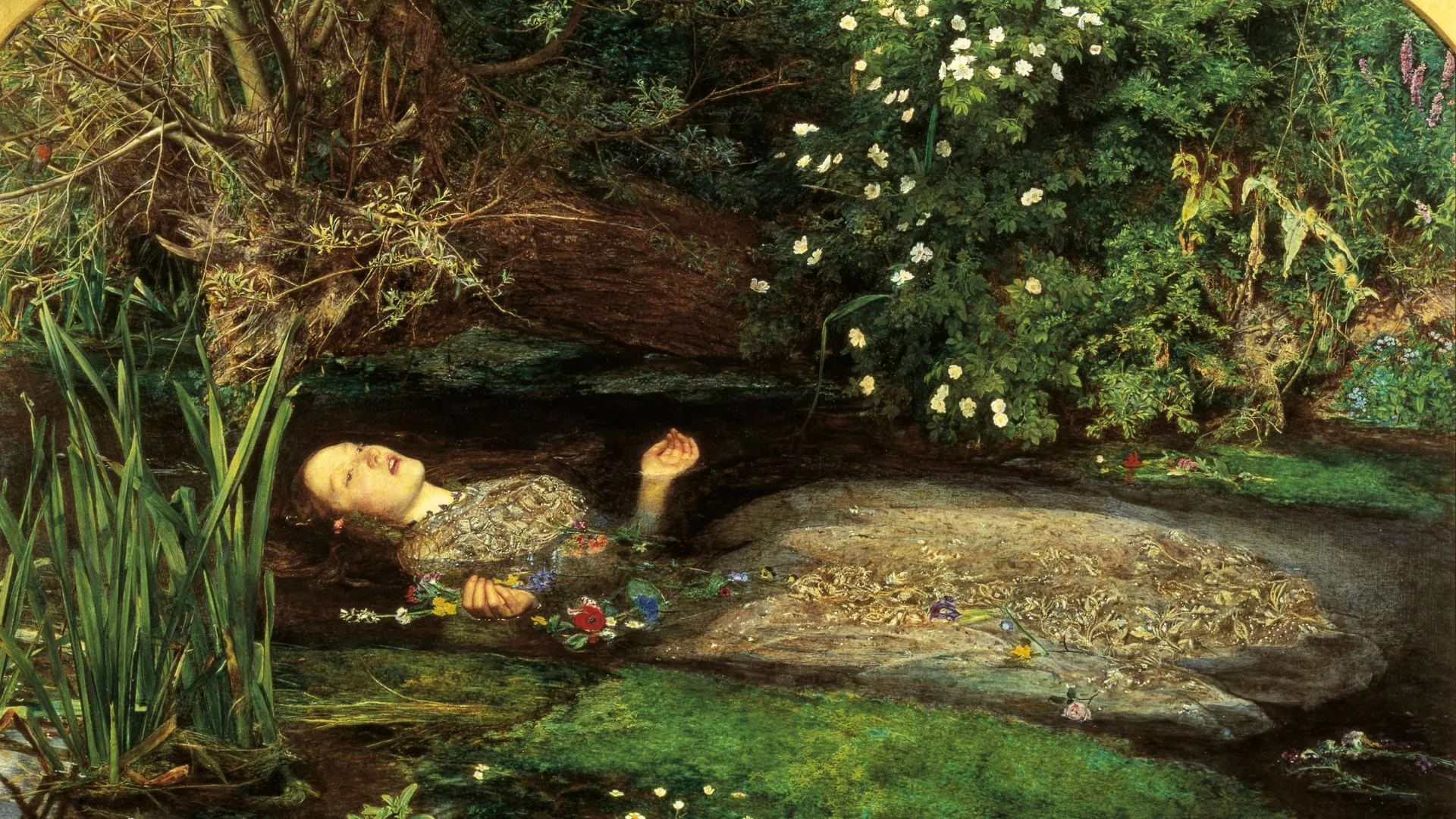THE RUNDOWN:
- Taylor Swift’s first song on The Life of a Showgirl is titled “The Fate of Ophelia”
- The title references the tragic heroine of Shakespeare’s 16th-century tragedy Hamlet
- Ophelia has become a feminine archetype in psychoanalysis, art and literature, representing female frailty and dependence. But in The Fate of Ophelia Taylor Swift gives the tragic figure new meaning.
The Life of a Showgirl is here, and its first track is taking the English Literature majors back in time. Taylor Swift opens The Life of a Showgirl with “The Fate of Ophelia,” and in doing so, she reframes one of literature’s most enduring victims. Recasting Shakespeare’s doomed heroine as a woman reborn through love, the track hits a strange cord with a mix of boppy beats and haunting lyrics. It’s also a shout-out to the album’s overarching theme: Swift is done with pining and has found her emotional centre, but it’s been a long, arduous journey for this Showgirl to get there.
Who Is Ophelia?
Ophelia is one of the most tragic figures in Shakespeare’s Hamlet. A young noblewoman, she’s caught between the demands of her father, Polonius, and the affections of Prince Hamlet — a man who both professes love and then cruelly rejects her. Amidst the murder of her father and increasingly cold and erratic behaviour from the object of her affections, Ophelia opts out, descending into madness and eventually drowning herself. Her cause of death, mishap or suicide, is left ambiguous.
In Victorian art, Ophelia was romanticised as a beautiful, broken girl, drifting among waterlilies. In feminist theory, she has come to represent the psychic injuries that women who shape themselves to the whims of men inflict on themselves. She is, in many ways, the archetype of the woman undone by love and betrayed by the patriarchy (her brother and father) who promised to protect her.
Related: I Only Have One Word For Taylor Swift After Listening To ‘Wood’: Nice

The Fate Of Ophelia Lyrics:
[Verse 1]
I heard you callin’ on the megaphone
You wanna see me all alone
As legend has it, you are quite the pyro
You light the match to watch it blow
[Pre-Chorus]
And if you’d never come for me
I might’ve drowned in the melancholy
I swore my loyalty to me (Me), myself (Myself), and I (I)
Right before you lit my sky up
[Chorus]
All that time
I sat alone in my tower
You were just honing your powers
Now I can see it all (See it all)
Late one night
You dug me out of my grave and
Saved my heart from the fate of Ophelia (Ophеlia)
Keep it one hundred on the land (Land), thе sea (The sea), the sky
Pledge allegiance to your hands, your team, your vibes
Don’t care where the hell you’ve been (Been) ’cause now (Now), you’re mine
It’s ’bout to be the sleepless night you’ve been dreamin’ of
The fate of Ophelia
[Verse 2]
The eldest daughter of a nobleman
Ophelia lived in fantasy
But love was a cold bed full of scorpions
The venom stole her sanity
[Pre-Chorus]
And if you’d never come for me (Come for me)
I might’ve lingered in purgatory
You wrap around me like a chain (A chain), a crown (A crown), a vine (A vine)
Pullin’ me into the fire
[Chorus]
All that time
I sat alone in my tower
You were just honing your powers
Now I can see it all (I can see it all)
Late one night
You dug me out of my grave and
Saved my heart from the fate of Ophelia (Ophelia)
Keep it one hundred on the land (Land), the sea (The sea), the sky
Pledge allegiance to your hands, your team, your vibes
Don’t care where the hell you’ve been (Been) ’cause now (Now), you’re mine
It’s ’bout to be the sleepless night you’ve been dreamin’ of
The fate of Ophelia
[Bridge]
‘Tis locked inside my memory
And only you possess the key
No longer drowning and deceived
All because you came for me
Locked inside my memory
And only you possess the key
No longer drowning and deceived
All because you came for me
[Chorus]
All that time
I sat alone in my tower
You were just honing your powers
Now I can see it all (I can see it all)
Late one night
You dug me out of my grave and
Saved my heart from the fate of Ophelia (Ophelia)
Keep it one hundred on the land (Land), the sea (The sea), the sky
Pledge allegiance to your hands (Your hands), your team, your vibes
Don’t care where the hell you’ve been (Been) ’cause now (‘Cause now), you’re mine
It’s ’bout to be the sleepless night you’ve been dreamin’ of
The fate of Ophelia
[Outro]
You saved my heart from the fate of Ophelia
The Meaning Of The Fate Of Ophelia:
![Taylor Swift's life of a showgirl album cover artwork with William Gorman Wills [Irish, 1828-1891] Ophelia and Laertes 1879 Oil on canvas.](https://api.photon.aremedia.net.au/wp-content/uploads/sites/6/2025/10/the-fate-of-ophelia-1-68dfac5032ab6.jpg?resize=1920%2C1080)
In Shakespeare’s Hamlet, Ophelia is betrayed, abandoned, and ultimately loses her mind. She’s long been interpreted as a tragic casualty of patriarchal systems: controlled by her father, discarded by her lover, and remembered only in death. When she descends into madness and drowns — singing as she sinks — it’s easy to see why Swift, who also frames herself as a victim of the patriarchy in Father Figure, might relate. But in The Fate of Ophelia, she rewrites the ending.
She refers to a “you” who comes to her aid: “I heard you callin’ on the megaphone / You wanna see me all alone.”
Swift is referencing her fiancé, Travis Kelce, who she famously described as using his podcast as a “megaphone” to reach her after her team declined a meeting during the Eras tour. Here, Swift positions herself as an Ophelia not undone by heartbreak, but bitterness: “And if you’d never come for me / I might’ve drowned in the melancholy.”
While some argue that Kelce entered her life at its peak — during the Eras — others point out that it followed a series of romantic lows. In 2023, Swift ended her six-year relationship with Joe Alwyn, followed by a brief, highly scrutinised fling with The 1975’s Matty Healy. That romance became a centrepiece of The Tortured Poets Department, where Swift portrayed herself driven to “madness” by a Dylan Thomas wannabe “for whose sins she would have died for.”
Read alongside The Fate of Ophelia, the subtext sharpens: Matty Healy is the self-absorbed Hamlet, and Swift is the collateral damage.
Related: Why Fans Think Taylor Swift’s ‘Boring Barbie’ Leaked Lyric Is About Charli XCX
The drowned Ophelia has become an enduring symbol of lost innocence and emotional ruin. The term “Ophelia” is also often used to describe women perceived as delicate, hysterical and self-victimising Some of Swift’s critics might suggest turning a three-month fling into a double album was further proof Swift’s Ophelia-complex was showing.
In 1994, Mary Pipher coined the phrase in Reviving Ophelia, describing girls who construct performative selves and are overly dependent on male validation. But in Swift’s version, the tragedy isn’t dependence, it’s isolation. “I swore my loyalty to me (Me), myself (Myself), and I (I),” she sings, embittered. Later songs reveal that Swift wasn’t simply heartbroken — she was humiliated by alleged Healy allies like Charli XCX, who gets a pointed callout on the album. Alone in her tower, “drowning and deceived,” Swift depicts herself not as a fragile victim, but a wounded fortress.

So, back to Travis and his megaphone.
“You dug me out of my grave,” she sings, followed by “Pledged allegiance to your hands, your team, your vibes” — a direct nod to Kelce’s NFL team, the Kansas City Chiefs, and the simpler life she’s chosen with him.
This might initially seem like a retrograde fairytale rescue — but read in parallel with Swift’s other Shakespearean sonnet, Love Story (2008), it charts the full arc of her romantic imagination. At 19, Swift penned the ultimate fantasy: Romeo begs Juliet to marry him: “I talked to your dad, go pick out a white dress.” It’s a vision of love shaped by youth and simplicity.
Since then, Swift has lived — and chronicled — many disappointments. When The Fate of Ophelia was announced, fans joked, “She wanted to be Juliet but ended up Ophelia.”
By the song’s end, she’s neither, but she has found the more straightforward love she’s been looking for for almost 20 years.
There’s a feminist charge in that reframing. By reclaiming a literary figure often associated with fragility, Swift reasserts her autonomy and reconfigures emotional weakness as a form of emotional truth. The album’s cover art made this clear: half-submerged in water, Swift echoes John Everett Millais’ famous 19th-century Ophelia painting. But where Millais’ Ophelia is limp and glassy-eyed, Swift is lucid, reflective, and poised to re-emerge.
The Fate of Ophelia is a stark self-portrait and strangely gothic tribute to her fiancé, Travis Kelce (don’t worry, if you need a more lighthearted one, go for “Wood”). Where Midnights and The Tortured Poets Department delved into fractured identities and post-romantic fallout, The Life of a Showgirl opens with a woman who has faced the abyss and has found a place of emotional safety and simplicity.












